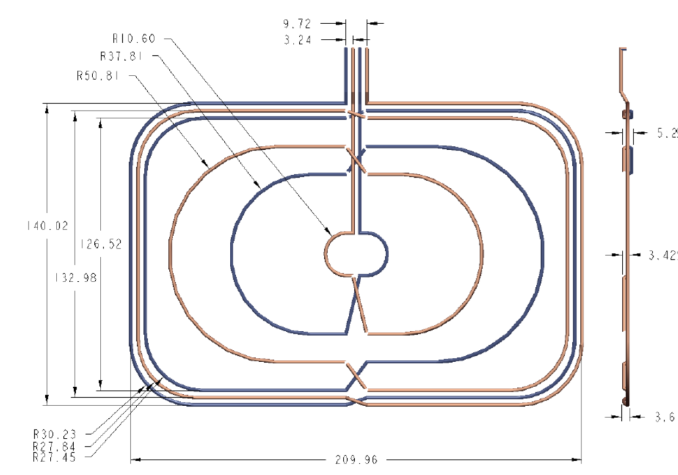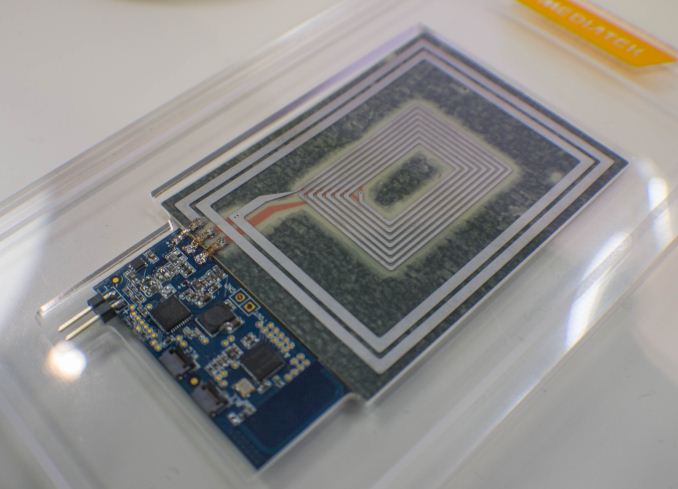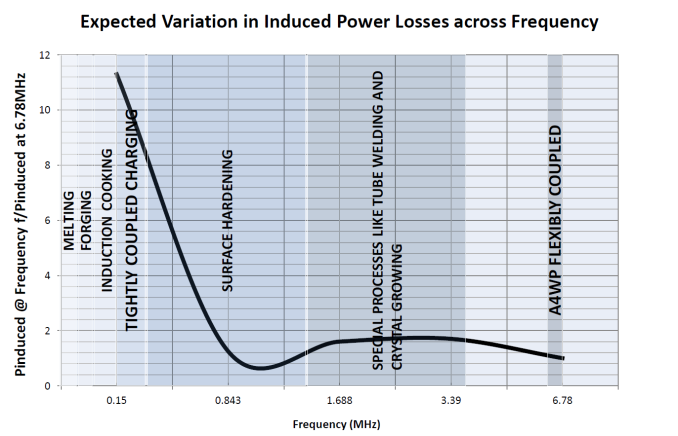The State of Wireless Charging Standards in Mobile
by Andrei Frumusanu on April 2, 2015 8:00 AM ESTRezence Resonance Charging
Earlier we saw the distinction between tightly coupled (TC) and loosely coupled (LC) induction charging systems. While A4WP’s Rezence system is called a magnetic resonance charging system, the basic principle is still based on magnetic induction. The critical difference between Qi and Powermat standards is that it is a Rezence is based on a loosely coupled coil system.
Inductive power frequencies and use-cases (Source)
A4WP systems work on a much higher frequency compared to tightly coupled systems such as defined by PMA and WPC. Rezence’s operating frequency is defined on a strict 6.78MHz (±15kHz) band compared to the 110-357kHz range that Qi and Powermat operate in.
Instead of a tight coil on the transmitter and receivers, we see the usage of a specifically shaped resonator designs. An A4WP transmitter has typically larger footprint than Qi or Powermat designs, with various classes of designs available depending on power requirement. Currently the widely adopted one is the Class 3 transmitter which has a size of 204x146mm and meant for smartphone device use-cases.


A4WP Class 3 spiral type 235-135 power transmit resonator (Source 1, Source 2)
The class system allows A4WP for a variety of size power transmitter unit (PTUs) and power receiving unit (PRUs) resonator coil systems depending on the number of devices and power you are targeting to charge. The class 3 PTU supports up to 16W transmit power.
| PTU Class | Maximum transmission in power |
Minimum PRU Support |
| Class 1 | TBD | >1 x Category 1 |
| Class 2 | 10W | 1 x Category 1, 2, or 3 |
| Class 3 | 16W | 2 x Category 1,2, or 3, or 1 x Category 4 |
| Class 4 | 22W | 3 x Category 1, 2, or 3, or 1 x Category 4 |
| Class 5 | TBD | TDB |
| PRU Category | Maximum reception out power |
Example Applcations |
| Category 1 | TBD | BT headset |
| Category 2 | 3.5W | Feature Phone |
| Category 3 | 6.5W | Smart Phone |
| Category 4 | TBD | Tablet |
| Category 5 | TBD | Laptop |
The current PRU categories are mainly defined for feature phone and smartphone devices with output powers of respectively 3.5 and 6.5W. We should be seeing class 3 devices as the most prevalent category implemented in smartphones in the near future. A class 3 PTU can charge at least two class 3 PRUs at full power, which should be sufficient for most use-cases.
A4WP WPT multi-device charging architecture (Source)
As mentioned before, the LC design of the Rezence charger allows for multiple receivers for a single transmitter, enabling a "star network" of PRUs for each PTU.
While Qi and Powermat respectively use either modulation on the power signal and RFID for communication between the transmitter ans receiver devices, Rezence work with a Bluetooth Low Energy (BLE) connection between all the different actors. There is no device pairing involved as communication is done over GATT (Generic Attribute Profile), a BLE feature.
At MWC2015 multiple vendors were demonstrating their A4WP implementations and chargers, and it was much more impressive to see them in action compared to the TC systems such as Qi and Powermat. Mediatek had a vertically standing Rezence charger which was demonstrated on a Galaxy S4 with custom backplate integrating Mediatek's tri-standard charging solution and powering the device via the dedicated power pins.
Practically, Rezence also seems to be the better solution as one doesn't have to deal with alignment of the device on the charging surface. Charging surfaces can vary in size and have an advantage of reduced complexity as it still remains a single resonator coil, where as Qi requires multiple overlapped coils to achieve the same effect and Powermat doesn't allow such flexibility in the first place.
Closing Thoughts
Having shed a bit more light on the difference and characteristics of the three main charging standard today, the question is on how the future of wireless charging will look. There is an undisputable battle of politics going on between the different standards associations, with each wanting to have their say and their own solutions to the wireless power transfer problem. Though right now the odd man out in all of this is the PMA, as it's hard to argue that Powermat brings any tangible advantages over Qi, not to mention it's a much less widespread standard.
Rezence from the A4WP on the other hand seems to be promising. The A4WP sees tightly coupled systems as first-generation technology that will in the future be replaced by loosely coupled charging implementations such as Rezence. I don't think the lesser charging efficiency will be something that people will mind as the practicality improvements clearly outweigh the disadvantages. The PMA-A4WP merger is seen as a technology swap as the A4WP gains access to a tightly coupled standard and the PMA gets access to a loosely coupled standard.
Meanwhile the WPC is working on its own resonance based loosely coupled system to compete with Rezence, but it's still in the development and we don't yet have much information on it.

MediaTek's tri-standard charging solution demonstration board
IC designers are going forward with tri-standard compatible solutions for wireless charging and that's what I envison will be the the aim for most device manufacturers who will want to include wireless charging into their products. This solves the device compatibility issue, but doesn't solve the problem completely as not all devices will be able to adopt it due to differing form factors. Rezence here again offers the best offering for form factor diversity, power transfer and charger interoperability. Though with the number of factions involved in this battle, it's not necessarily a given that this will be a battle won by technology as opposed to politics.
Ultimately the wireless charging ecosystem has changed a lot over the last few years, and things could again change drastically over the next few years, so nobody knows for sure in which direction the market will shift. We'll be sure to keep an eye on WPT in the future and cover any emerging news on the topic.












90 Comments
View All Comments
blanarahul - Thursday, April 2, 2015 - link
Exactly. They are trying to solve a problem that doesn't even exist.khanikun - Thursday, April 2, 2015 - link
We had regular mobile phones before. There was no problem to solve, but we still ended up getting smartphones.blanarahul - Thursday, April 2, 2015 - link
We got to smartphones little by little. First games, then E-Mail, then IM then something else and so on. So a need was slowly created. But with wireless charging, there is no need. It's just for a minor convenience.khanikun - Friday, April 3, 2015 - link
There was never a need or a problem. It was simply companies creating something and pushing it onto the market, to try and differentiate themselves from everyone else. Get you to buy their product instead of someone else's product.The same with all these random features we get now on phones. NFC, wireless charging, etc.
Murloc - Tuesday, April 7, 2015 - link
smartphones solve the same problem personal computers from the 90s solve, they just do it better.sonicmerlin - Thursday, April 2, 2015 - link
You seriously don't see how convenient it would be to just plunk down your laptop and phone onto a table and have them automatically charge?blanarahul - Thursday, April 2, 2015 - link
No. Because it takes only 2-3 more seconds to put the damn cord it. Plus I can move it around a little if I need to.kyuu - Friday, April 3, 2015 - link
As someone who used Qi charging with my Lumia 920 then had to give it up when I got the 1520... wireless charging is much more convenient than using the mUSB, no question. It's not a deal breaking thing, but I definitely prefer having the option. It's particularly nice when trying to get into bed without disturbing the significant other, rather than fumbling with a cord in the dark.sonicmerlin - Friday, April 3, 2015 - link
You'll be able to charge multiple devices with one charger. You could put a giant magnetic resonance coil in your monitor and charge everything by just placing it on the same table as your monitor.Notmyusualid - Thursday, April 2, 2015 - link
My brother and I both use Qi charging.His 'puck' arrived with his Lumia 925? I had to buy the wireless S-View Case to enable my GS5, and also a seperate Qi charger, which is actually a dual charger / alarm clock.
When either of us arrive home, instead of putting oru phones down on the table, we rest them on their chargers. No messing around, just put it there. (for me it also means I don't have to open the waterproof usb door, and remember to close it too).
Thus; whenever either of us leave the house, our cellphones are ALWAYS at 100% charge capacity. Again, making us more 'mobile'.
I do think about the power transfer and associated losses, but then my house is littered with low-energy bulbs, AND I buy 100% of my energy from renewable sources (it costs a little more), so I don't think I'm killing polar bears, so to speak.
Try it, you might like it.